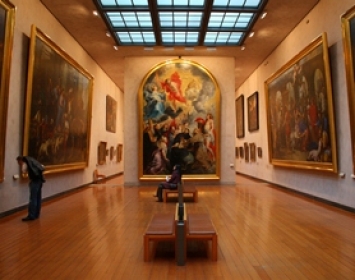All about museums and exhibitions

Fine Arts and Applied Arts
Fine art or the fine arts encompass art forms developed primarily for aesthetics and concept rather than practical application. Historically, the five greater fine arts were painting, sculpture, architecture, music and poetry, with minor arts including drama and dancing. Today, the fine arts commonly include the visual art and performing art forms, such as painting, sculpture, collage, decollage, assemblage, installation, calligraphy, music, dance, theatre, architecture, film, photography, conceptual art, and printmaking.
Applied art is the application of design and aesthetics to objects of function and everyday use. Whereas fine arts serve as intellectual stimulation to the viewer or academic sensibilities, the applied arts incorporate design and creative ideals to objects of utility, such as a cup, magazine or decorative park bench. The fields of industrial design, graphic design, fashion design, interior design, decorative art and functional art are altogether considered applied arts.
Different kinds of museums:
archaeological: statues, artefacts, bodies (skeletons, mummies), tombs, buildings (ruins), aqueducts, archaeological digs
art: galleries, paintings, pictures, photographs, statues, installations
historic house: gardens, old houses (country manors, mansions, palaces, castles), rooms, galleries, antique furniture, weaponry, armour
maritime: ships, boats, fishing nets, submarines, uniforms, photos, models, maps, compasses, oxygen tanks, diving equipment
war: weapons, planes, uniforms, helmets, tanks, canons, cannonballs, photographs, medals
specialized: cinematic, clock, waxworks, toy, etc.
science: flight, space flight, scientist, experiments, planetarium (stars, planets, astronomy), interactive exhibits
natural history: animals (stuffed animals, pre-historic, dinosaurs), evolution, fauna and flora
fine art [faɪn ɑːt] – képzőművészet
applied art [əˈplaɪd ɑːt] – iparművészet
to encompass [tu ɪnˈkʌmpəs] – körülvesz, körülölel
to develop [tə dɪˈveləp] – fejlődik, fejleszt
primarily [ˈpraɪmərəli] – elsődlegesen
aesthetics [iːsˈθetɪks] – esztétika
rather than [ˈrɑːðə ðæn] – inkább, mint
practical application [ˈpræktɪkəl ˌæplɪˈkeɪʃən] – gyakorlati felhasználás
historically [hɪˈstɒrɪkəli] – történelmileg
painting [ˈpeɪntɪŋ] – festészet
sculpture [ˈskʌlptʃə] – szobrászat
architecture [ˈɑːkɪtektʃə] – építészet
poetry [ˈpəʊɪtri] – költészet
to include [tu ɪnˈkluːd] – magába foglal
application of [ˌæplɪˈkeɪʃən ɒv] – valaminek az alkalmazása
to incorporate [tu ɪnˈkɔːpəreɪt] – egyesít, magába foglal
artefact [ˈɑːtɪfækt] – tárgyi lelet, műalkotás
tomb [tuːm] – sír
weaponry [ˈwepənri] – fegyverzet
armour [ˈɑːmə] – páncélzat
At the museum

to be on display – kiállítva lenni
exhibition – kiállítás
temporary exhibition – időszakos kiállítás
permanent exhibition – állandó kiállítás
to exhibit – kiállít
collection – gyűjtemény
art gallery – képtár, műcsarnok
to hang a painting – kiakaszt egy képet
hall – csarnok


